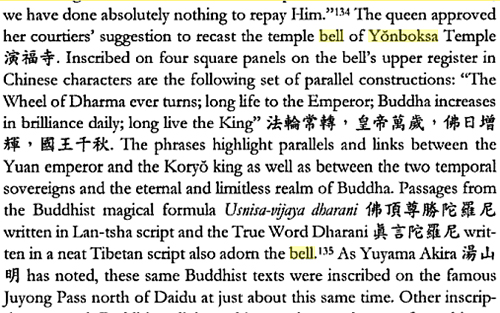 Someone sent in this inscription transcribed from a Korean bell - (14-15th C?) at the Jogye-sa Temple, Seoul. The bell also had It also had 'namo Amitabha' in Chinese on it.
Someone sent in this inscription transcribed from a Korean bell - (14-15th C?) at the Jogye-sa Temple, Seoul. The bell also had It also had 'namo Amitabha' in Chinese on it.The question is what do these lines say? They are clearly a Brahmi derived script - related to Siddhaṃ or Ranjana. I've come across one or two other similar Korean inscriptions but have yet to find a definitive guide to help me read them.
One useful source is found in: Tatsuon Maruyama. Sanskrit-Japanese dictionary of dharanis: The Darani-jiten (Sata-pitaka series : Indo-Asian literatures) International Academy of Indian Culture, 1981. This has a Korean syllabary (P.48 f) but it is not identical to the kinds of inscriptions I've seen. So I cannot confidently read this inscription. I'll give my guesses but I would very much like to here from anyone who can read this!
The first character in both lines is oṃ. Actually I think this is the only example I have seen of auṃ in a Buddhist inscription. The other characters all look to be single syllables rather than conjuncts which makes it easier.
So line 1 character 1 (1.1) is oṃ. 1.2-4 are repeated at 2.6-8. 1.2 looks most like bha, but I would hold open the possibility of ha. 1.3 looks like ta. 1.4 could be ka, but I think it is na. In some early forms of Siddhaṃ one sees this style of na which was the template for the Tibetan na. This gives us oṃ bha ta na, or ha ta na (with bha ta ka as an outside possibility). My correspondent (who is very familiar with Sanskrit) thought the marks on the top left of some characters are 'e' diacritics. It's a bit inconsistent to be sure. The obviously problem with this reading is that none of the possibilities are Sanskrit or anything like Sanskrit. So I've got it completely wrong, or this is not Sanskrit. Certainly Siddhaṃ is used to write Japanese in contemporary Japan, but usually only as a novelty item.
On line two we begin with oṃ again. 2.2 I read 'na' (as above). 2.3 seems very likely to be va or ba. 2.4 looks like ca. 2.5 offers some possibilities. Ya might be an obvious guess, but going by the Dictionary of Dhāraṇīs I would expect the ya to be more like the Ranjana ya - less rounded. From the same source both pa and gha appear similar. 2.6-8 as I say are as above. Again this is either completely wrong or not Sanskrit.
oṃ bha ta ne
oṃ na va ca pa bha ta na
oṃ na va ca pa bha ta na
If anyone can do better than this I would be delighted to hear from you!
My friend Maitiu has written to me about this:
My friend Maitiu has written to me about this:
My first thought was that it looked like the Bhujimol script of Nepal. I thought the second syllable (1.2) was a da (if you look at the related modern Bengali script you can see the similarity) but I'm not sure the mantra makes any sense if you do that. The 1.3 looks like a Bhujimol ra and 1.4 looks like an unusual ka. 2.3 looks like a va or ba but 2.4 is ca which suggests vaca. If 2.2 is ka that would give kavaca, armour, war-drum, amulet, especially a charm inscribed with a bīja. Kavaca is a classic piece of Tantric terminology.I've noticed in looking Siddhaṃ mantras in the Taisho Tripitaka that vowels can be shifted inadvertently - perhaps a shift from bhī > bhe may be understandable (I've seen speculation that this might be due to the accents of some of the intermediaries). So the mantras here might also be:
2.5 could be a pa or a ya, they're hard to tell apart in Bhujimol, but it looks more like a ya and that would probably make more sense. Going back to 1.2 it doesn't look exactly like a Bhujimol bha but it's close enough to be possible. I'm assuming that the mark on the head bar of this syllable is an e diacritic and then 1.2-3 would give bhera, a kettle-drum, from the root bhī. Bheraka isn't in the dictionary but bhīraka, bhīruka meaning fearful, formidable derived from the same root. Anyway that's my best guess at trying to decipher the mantra. It's a shame we can't see the original. The script doesn't seem to be exactly Siddhaṃ or Bhujimol but another intermediate form of the Eastern Devanagari script.
oṃ bheraka
oṃ kavaca bheraka
This is certainly more plausible, though I can't find this mantra or a mantra of which this is a fragment.oṃ kavaca bheraka
14.6.10
My informant tells me that there are similar inscriptions on the Yonboksa Bell.
The last Indian Acārya to visit Korea was Chikong (Dhyānabhadra). He arrived in Korea in the 1340s and established the Juniper Rock Monastery on the pattern of the Nalanda University. Its foundations can be seen near Seoul. He wrote Sanskrit dhāraṇī-mantras on the gigantic Yonboksa Bell for the liberation and peace of the Korean People from Mongol dominatio [Lokesh Chandra. 'Interface of India with other Asian Lands.' Dialogue July - September, 2003 , Volume 5 No. - online www.asthabharati.org]
Also in: Robinson, David M. Empire's Twilight: Northeast Asia Under the Mongols (p.122)
Google Books.
48VUPQ3F2G2W


No comments:
Post a Comment